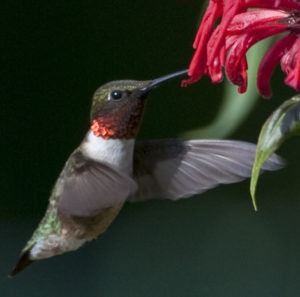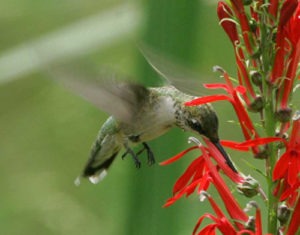Ruby-throated hummingbirds are the only hummingbirds that nest in the eastern United States. They arrive in Kentucky between mid-March and early April. The males arrive first and set up territories. When the females arrive, the males display to attract the females. The male’s mating display is a series of long swoops that look like he is repeatedly writing the letter “J” in the sky. He punctuates his swoops with sharp chirps. If the female likes what she sees and likes the territory, she will mate with him. Afterwards, the male returns to the job of attracting females and chasing other males out of the territory.

The female ruby-throated hummingbird builds her nest out of lichen, spider webs, and bits of leaves. She lays two eggs and does all of the incubating. The eggs hatch in approximately 12-14 days. The young chicks grow quickly on a diet of protein rich insects that the female catches and brings back to them.
We think of hummingbirds as nectar feeders and thus pollinators. However, they also eat a significant number of ants and other small insects. The insects are even more important to the nestlings than to the adults because the nestlings need the extra protein in order to grow. They will double their weight every few days for the first couple of weeks. Approximately three weeks after hatching, the young hummingbirds fledge.
Attracting hummingbirds to your yard is easy. Hummingbirds are attracted to a variety of flowers, especially red or orange flowers that have a tubular shape. Planting a wide variety of flowers that are attractive to hummingbirds and will bloom throughout the summer will provide the hummingbirds with a plentiful supply of natural food.
It is also possible to supplement their natural food supply with feeders. A variety of hummingbird feeders are available at most stores that sell bird feeding supplies. Putting out several small feeders is preferable to a single large feeder. If you only have one feeder then one or two birds can dominate the feeder and run off all of the other hummingbirds. Multiple feeders prevent that from happening and allow more hummingbirds the opportunity to drink at the feeders.
The most important thing about putting up a hummingbird feeder is caring for and maintaining it. When you first get a hummingbird feeder, give it a good cleaning. The feeding solution is simple to make and consists of 1 cup of sugar mixed with 4 cups of water. There is no reason to color the water or buy commercial mixes that are more expensive than plain sugar. If possible, hang the feeder where it gets some shade, because the shade will help keep the solution cool and keep it from spoiling as fast.

Clean the feeders and change the solution every few days during the middle of the summer when it is hottest and at least once a week when it is cooler. If you notice mold on the glass or feeding ports or if the water starts to get cloudy, then you need to clean the feeder and change the water. A good way to keep from having to throw away solution is to only put out what you estimate the birds will drink in a couple of days. Don’t worry if the feeders run out. The birds know where other food sources are and will readily switch to those until you refill the feeders.
In late summer, the male hummingbirds will begin migrating back to Mexico and Central America. Later in the fall, the females and young of the year will follow. Migration is triggered by day-length and takes place when there are still plenty of flowers for the birds to feed upon during migration. You don’t have to worry about leaving your feeders up “too long” and thus keeping the hummingbirds from migrating. Later this fall, we’ll talk about late migrants, what that might mean, and what you can do.

This article was part of Shannon’s original Kentucky Pollinators and Backyard Wildlife blog which evolved into the blog for Backyard Ecology.

Backyard Ecology: Exploring Nature in Your Backyard
Nature isn’t just “out there.” It’s all around us, including right outside our doors. Hi, my name is Shannon Trimboli, and I am the host of Backyard Ecology. I live in southcentral Kentucky and am a wildlife biologist, educator, author, beekeeper, and owner of a nursery specializing in plants for pollinators and wildlife conservation. I invite you to join me as we ignite our curiosity and natural wonder, explore our yards and communities, and improve our local pollinator and wildlife habitat. Learn more or subscribe to my email list at www.backyardecology.net.

Leave a Reply